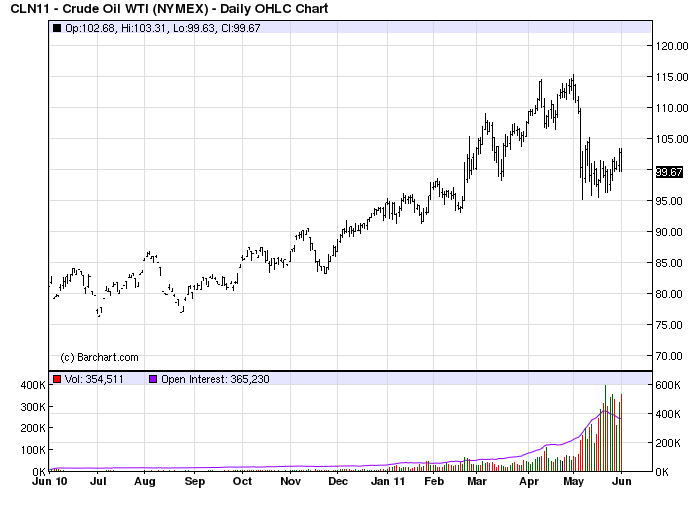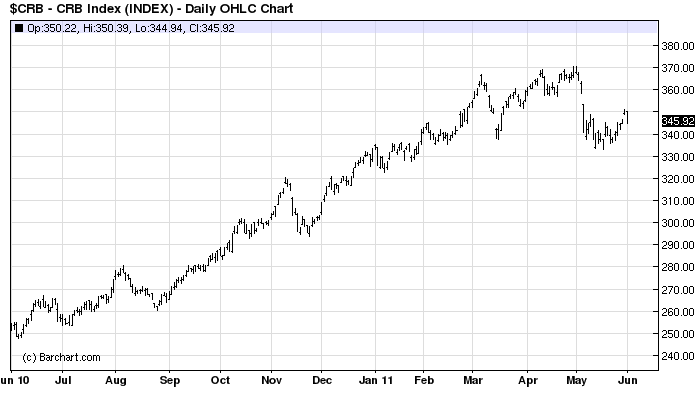
Breaking news! Last night, Federal Reserve Chairman, Ben Bernanke, announced he is pregnant. A glowing Bernanke told a packed press conference that the child was neither a girl nor a boy. It was, in fact, a third round of quantitative easing. The child is expected to be born before the year is out.
Don’t say I didn’t warn you.
Last night’s US data was awful. The all important ISM, the leading gauge of factory activity, collapsed 7 points in May to sit in a still reasonable but rapidly waning level:

To make matters worse the ADP employment number for May also dramatically undershot expectations, adding just 38,000 jobs for the entire US economy. To keep that in perspective, the Australian economy added 50,000 in a single month earlier this year. The ADP report is not always a precise guide on the government BLS survey (out Saturday our time) but in trend terms it’s a useful indicator.
This shocking data crushed the Dow and commodities.
The obvious conclusion to draw from the sputterings of the US economy is that more QE is coming.
Yesterday my favourite Fed commentator, Tim Duy, had this to say on current Fed policy:
To what extent will incoming data impact monetary policy? At this point, I think policymakers are still in “wait and see” mode. To be sure, they cannot ignore the spate of weak data. I think it has to be a topic in upcoming speeches. But they can continue to view it as a temporary blip. Moreover, I think it has been made clear that there is a high bar for QE3 – especially as the commodity-induced inflation mouse passes through the belly of the snake. Which means that while the specter of inflation remains alive and well on Constitution Ave., we should expect at most talk of pushing back the eventual policy tightening. But I think we would need to see a serious downgrade of the 2012 forecast to push the Fed into another round of asset purchases.
I agree. But make no mistake, those downgrades are coming. The Fed will also have to wait until commodities sell off some more, but in my view they will push the button.
However, it’s not that simple. Let’s see where commodity prices sat during last year’s double-dip scare and QE2. First, the CRB:
QE2 was announced at the end of August. That’s a long, long way down down from here. And now, perhaps more importantly for the US economy, oil:

Not quite so far but still some distance. I must admit, when I look at these charts, the conclusions that present themselves aren’t pretty. The Fed has consistently argued that the US economy’s output gap, expressed through high unemployment, will prevent any enduring inflationary outburst. I agree. But at the same time, the US economy has slowed so fast that commodities remain very elevated so, as Tim Duy put it, the mouse of high input costs hasn’t got much time to pass through the snake.
The Fed thus has a problem. It has so firmly established its credentials as a monetary bailout machine that markets may shift very quickly to the expectation of QE3 and commodities may not sell off quickly enough to enable a new round of stimulus that doesn’t also trigger a new round of destabilisingly high commodity inflation.
In the case of oil, the crucial price, there is the added problem of the MENA crisis and the risk premium.
And it is oil that most needs to fall. From Gavyn Davies of the FT:
The latest revisions to US GDP statistics paint a troubling picture of the current state of the consumer sector, with the growth in real disposable income being revised down from about 2.5 per cent to only 1 per cent in Q1. There has been a corresponding downward revision to the household savings ratio, which is now estimated to have declined from 6.2 per cent in early 2010 to only 5 per cent now. This means that consumers are left with a smaller cushion of excess savings to dip into if oil prices should remain high, and most economists are busy revising downwards their projections for US real GDP as a result.
Thus, the key difference between the springtime dip in growth this year, compared to last, is that high oil prices are this time exerting a strong contractionary force on the global economy which is proving more powerful than many economic forecasters initially calculated. In the developed world, and especially in the US and the UK, households are already burdened with excess debt, and seem very reluctant to dip further into their savings in order keep the rest of their spending unchanged. Meanwhile, in the emerging world, the rise in oil and food prices is having similar effects, which are exacerbated by the policy tightening needed to control inflation.
As explained in this earlier blog, economic fundamentals suggest that oil prices may have trouble maintaining their present levels, and seem quite likely to drop by 10-20 per cent in coming quarters. If that proves correct, then the global slowdown, like last year’s, will prove temporary. If not, then it is a different ball game entirely.
So, could the Fed just sit back and let commodities deflate? Maybe. But to do so will smack global equities and US wealth, the $US is likely to rally and the source of the US recovery, its manufacturing exports, will get hit. The benefits from falling commodity prices may not be enough of an offset.
There is a growing risk too that if the Fed denies markets more stimulus too emphatically, commodities will crash.
We’re all now caught in a epic game of chicken with US monetary policy.


